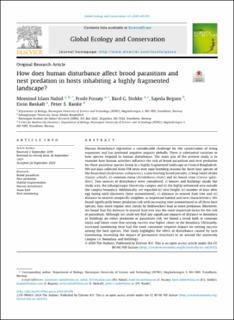| dc.contributor.author | Nahid, Mominul Islam | |
| dc.contributor.author | Fossøy, Frode | |
| dc.contributor.author | Stokke, Bård Gunnar | |
| dc.contributor.author | Begum, Sajeda | |
| dc.contributor.author | Røskaft, Eivin | |
| dc.contributor.author | Ranke, Peter Sjolte | |
| dc.date.accessioned | 2021-03-15T13:55:39Z | |
| dc.date.available | 2021-03-15T13:55:39Z | |
| dc.date.created | 2020-10-12T12:10:42Z | |
| dc.date.issued | 2020 | |
| dc.identifier.citation | Global Ecology and Conservation. 2020, 24 . | en_US |
| dc.identifier.issn | 2351-9894 | |
| dc.identifier.uri | https://hdl.handle.net/11250/2733458 | |
| dc.description.abstract | Human disturbance represents a considerable challenge for the conservation of living organisms and has profound negative impacts globally. There is substantial variation in how species respond to human disturbance. The main aim of the present study is to examine how human activities influence the risk of brood parasitism and nest predation for three passerine species living in a highly fragmented landscape in Central Bangladesh. We use data collected from 518 nests over nine breeding seasons for three host species of the Asian koel (Eudynamys scolopaceus), a non-evicting brood parasite: i) long-tailed shrike (Lanius schach), ii) common myna (Acridotheres tristis) and iii) house crow (Corvus splendens). Two sources of disturbance were considered: i) houses and buildings inside the study area, the Jahangirnagar University campus and ii) the highly urbanized area outside the campus boundary. Additionally, we regarded iii) nest height, iv) number of days after egg laying until discovery (time unmonitored), v) distance to nearest fruit tree and vi) distance to nearest conspecific neighbor, as important habitat and nest characteristics. We found significantly lower predation risk with increasing time unmonitored in all three host species, thus more regular nest checks by fieldworkers lead to more predation. Moreover, we found that the distance to nearest fruit tree was the most important factor for the risk of parasitism. Although we could not find any significant impacts of distance to boundary or buildings on either predation or parasitism risk, we found a trend both in common myna and house crow that nesting success was higher closer to the boundary. Ultimately, increased monitoring time had the most consistent negative impact on nesting success among the host species. This study highlights the effect of disturbance caused by nest monitoring, exceeding the impact of permanent structures in an around the university campus i.e. boundary and buildings. | en_US |
| dc.language.iso | eng | en_US |
| dc.publisher | Elsevier | en_US |
| dc.rights | Attribution-NonCommercial-NoDerivatives 4.0 Internasjonal | * |
| dc.rights.uri | http://creativecommons.org/licenses/by-nc-nd/4.0/deed.no | * |
| dc.title | How does human disturbance affect brood parasitism and nest predation in hosts inhabiting a highly fragmented landscape? | en_US |
| dc.type | Peer reviewed | en_US |
| dc.type | Journal article | en_US |
| dc.description.version | publishedVersion | en_US |
| dc.source.pagenumber | 14 | en_US |
| dc.source.volume | 24 | en_US |
| dc.source.journal | Global Ecology and Conservation | en_US |
| dc.identifier.doi | https://doi.org/10.1016/j.gecco.2020.e01295 | |
| dc.identifier.cristin | 1838841 | |
| dc.description.localcode | © 2020 The Authors. Published by Elsevier B.V. This is an open access article under the CC BY-NC-ND license (http://creativecommons.org/licenses/by-nc-nd/4.0/). | en_US |
| cristin.ispublished | true | |
| cristin.fulltext | original | |
| cristin.qualitycode | 1 | |

